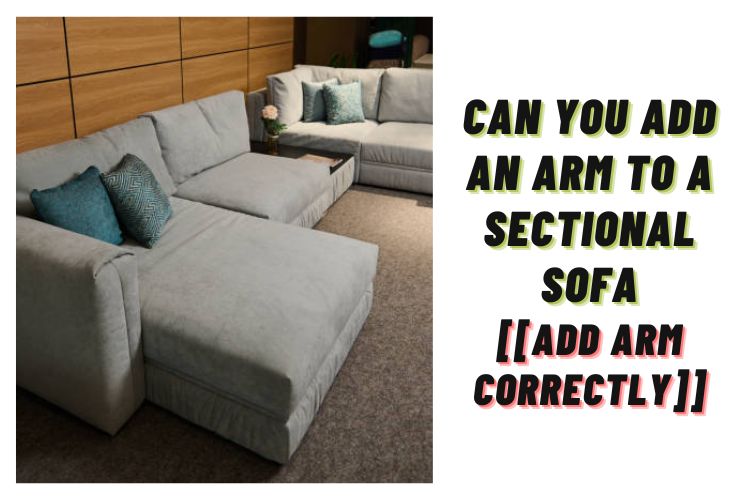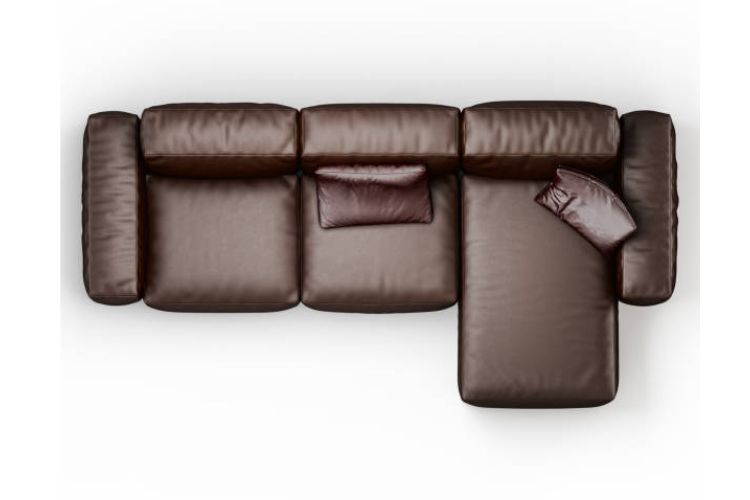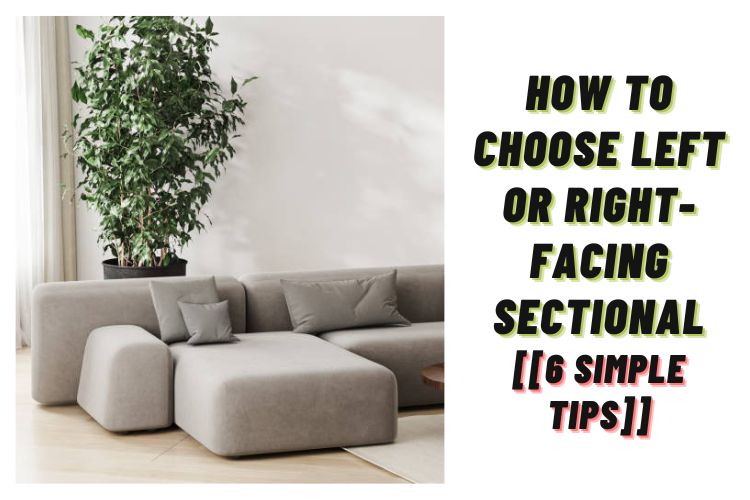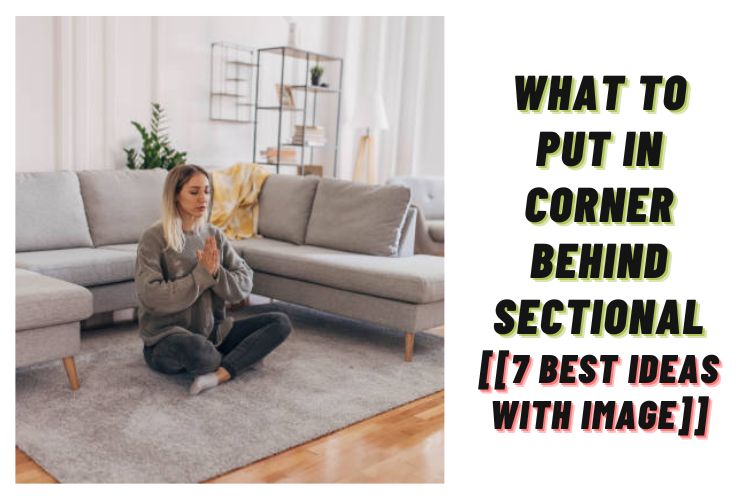Sectional sofas are the perfect choice for many living spaces, offering comfort and flexibility in terms of seating options. Whether you’re looking for a classic L-shaped sectional or something more unique like a U-shaped sectional with a chaise lounge, there is a wide range of types to choose from.

But what if you want an armless sofa that allows for adding an arm? It’s not impossible to find the perfect solution as there are several ways to add arms to your sectional couch. Read on to discover the best selection of sectionals with one-arm designs, modular pieces, corner sectionals, and cup holders – all perfect for making your living room furniture stand out!
What is the arm of a sectional?
A sectional’s arm is an integral part of its design; it serves as a support structure for the overall shape of the couch, while also providing extra seating. One-arm sectionals are made up of one piece that has an arm attached to it, allowing for additional seating and more flexibility in terms of how the space is arranged.

This type of sofa can be used to create unique floor plans with different seating arrangements, making it a popular choice for larger living rooms.
Are sectionals comfortable?
Yes, sectionals are pretty comfortable. Sectional sofas provide a wide range of seating options that make them a popular choice for living rooms. Whether you’re looking for an L-shaped sectional, U-shaped sectional, chaise sectional, corner sectional, or one-arm sofa, these pieces of furniture can be arranged to fit just about any floor plan.
Note: Some modular sectionals have extra features such as cup holders and chaise lounges to make them even more comfortable.
Can you add an arm to a sectional sofa?
Sectional sofas can be an ideal choice when it comes to furnishing your living space. These types of couches come in a wide range of shapes, sizes, and styles. Whether you are looking for a traditional L-shaped sectional or a modern U-shaped sectional, there is sure to be something that meets your needs. But what if you don’t want an armless sofa? Is it possible to add an arm to a sectional sofa?

The answer is yes! Many different sections from various manufacturers offer the opportunity to customize your sofa by adding one or more arms. For example, modular sectionals provide the ultimate flexibility as they allow you to create virtually any shape with multiple pieces of furniture.
How to add an arm to a sectional sofa?
To add an arm to a sectional sofa, follow these detailed steps:

| Steps | Explanation |
| 1. Measure and purchase the arm: | Begin by measuring the length and height of the existing sectional sofa arm. Ensure that the new arm matches these measurements accurately. Choose an arm that matches the style, color, and material of the existing sofa to maintain a cohesive look. |
| 2. Remove existing arm if necessary: | If there is an existing arm that needs to be replaced, carefully remove it by unscrewing or unbolting any screws or bolts that hold it in place. This step may vary depending on the design of your sectional sofa. |
| 3. Prepare the new arm: | Place the new arm next to the sectional sofa to ensure it aligns properly. If necessary, sand or trim the arm to fit perfectly with the existing sofa. Smooth any rough edges to prevent splinters or injuries. |
| 4. Attach the arm: | Position the new arm against the side of the sectional sofa where the old arm was removed. Ensure it is aligned properly and level with the sofa. Use screws or bolts to attach the new arm securely. Double-check that the arm is stable and doesn’t wobble. |
| 5. Reinforce the attachment: | If desired, reinforce the attachment of the new arm to the sectional sofa. This can be done by adding extra screws or brackets for added stability. Make sure the reinforcements are hidden or discreetly placed to maintain the sofa’s aesthetic appeal. |
| 6. Test the arm: | Once the new arm is securely attached, test its stability by applying gentle pressure. Sit on the sofa and lean against the arm to ensure it can withstand regular use. If the arm feels weak or unstable, reinforce it further or consider seeking professional assistance. |
| 7. Finishing touches: | Once you are satisfied with the newly added arm, inspect the surrounding area for any visible gaps or inconsistencies. If necessary, use wood filler or touch-up paint to blend the new arm seamlessly with the rest of the sofa. This final step will ensure a polished and cohesive appearance. |
Recommendation: Remember, the process of adding an arm to a sectional sofa may vary depending on the specific design and construction of your sofa. If you are unsure or uncomfortable with DIY methods, it is recommended to consult a professional furniture repair or upholstery service for assistance.
How to reverse a sectional sofa?
To reverse a sectional sofa, follow these detailed steps:

| Steps | Explanation |
| 1. Clear the area: | Begin by removing any items, such as coffee tables or side tables, from around the sectional sofa. This will provide ample space to maneuver and flip the sofa. |
| 2. Separate the sections: | If your sectional sofa has multiple pieces, detach them from each other. Most sectional sofas are held together with connectors or clips. Carefully remove these connectors to separate the sections. |
| 3. Protect the floor: | Place a soft, thick blanket or drop cloth on the floor to protect the sofa and the floor from any scratches or damage during the flipping process. |
| 4. Flip the sofa frame: | Start with the heaviest section of the sofa, typically the longer side. With the help of a friend or family member, lift and rotate this section of the sofa frame 180 degrees. Slowly lower it back down onto the blanket or drop cloth with the opposite side facing up. |
| 5. Flip the cushions: | Remove the seat and back cushions from the flipped section of the sofa. Rotate and flip them so that they fit properly on the newly flipped frame. Make sure the cushions are aligned and fit securely. |
| 6. Repeat for other sections: | If your sectional sofa has additional sections, repeat steps 4 and 5 for each section, one at a time. Lift, rotate 180 degrees, and lower the section onto the opposite side, then flip and align the cushions accordingly. |
| 7. Reconnect the sections: | Once all sections are flipped, carefully reattach them using the connectors or clips. Ensure that the sections are securely connected and aligned. |
| 8. Adjust and arrange: | Take a moment to adjust the cushions and pillows to your desired configuration. Fluff and arrange them evenly for a neat and comfortable appearance. |
| 9. Clean and inspect: | Before using the sofa, clean any dirt or debris that may have accumulated during the flipping process. Inspect the sofa for any damage or loose connections and make any necessary repairs. |
By following these detailed steps, you can successfully reverse your sectional sofa, giving it a fresh look and potentially changing the layout of your living space.
Can you turn a sectional into a sofa?
Yes, you can turn a sectional into a sofa. Sectional sofas are a popular choice for any living space, offering a wide range of seating options and an opportunity to create custom-made layouts. Whether you have an L-shaped sectional, U-shaped sectional, or corner sectional, it can be transformed into a comfortable couch with the addition of one arm.

A one-arm sofa will provide extra support and comfort, while also adding to the overall aesthetic of your living room furniture. There are several types of sectionals available on the market today, including armless sofas, chaise sectionals, modular sectionals with cup holders and chaise lounges, and curved sectionals that add a unique touch to your floor plan.
Can you split a sectional?
Yes, it is possible to split a sectional. By utilizing appropriate tools and techniques, you can separate a sectional sofa into smaller pieces, allowing for more flexibility in arranging your furniture.
How do you put a sectional together?
To put a sectional together, follow these steps:
1. Start by unpacking all the pieces of the sectional and lay them out in the room where you want to assemble them.
2. Identify the different sections of the sectional, such as the sofa, chaise lounge, corner piece, and any additional pieces like ottomans or armless chairs.
3. Connect the sections together using the provided connectors or brackets. These are usually located on the underside or back of the pieces and may require screws or other fasteners. Follow the manufacturer’s instructions for proper assembly.
4. Slide the sections together, ensuring that they align properly and securely connect. This may involve aligning brackets or inserting hooks into corresponding slots.
5. Check for any additional connection points, such as Velcro straps or clips, and secure them as required.
6. Arrange any loose cushions or pillows on the sectional for added comfort and aesthetics.
7. Once all the sections are securely connected, test the stability of the sectional by sitting on it or gently applying pressure.
8. Adjust the positioning of the sectional as desired to fit the layout of your room.
9. Make sure to tighten any loose screws or connectors and double-check that all pieces are properly attached for safety and stability.
If you encounter any difficulties or have specific instructions provided by the manufacturer, refer to those for guidance.
How to make a sectional into two couches?
To make a sectional into two couches, follow these steps:
1. Determine where you want to divide the sectional. This can be done by locating the seams or connectors that hold the sectional together.
2. Unscrew or detach any connectors or fasteners that are holding the sectional pieces together. This may involve removing screws or releasing latches, depending on the design of your sectional.
3. Carefully separate the sectional pieces, making sure to support the weight of each piece as you disconnect them. It may be helpful to have someone assist you in this process.
4. Once the pieces are separated, rearrange them to create two separate couches. You can position them side by side or in different areas of the room, depending on your preference.
5. If necessary, adjust the cushions or pillows to fit the new configuration of the couches.
6. If there are any gaps or exposed areas where the two couches meet, you can use decorative pillows, blankets, or fabric to cover these spaces and create a cohesive look.
7. Inspect the stability and comfort of each couch to ensure that they are secure and comfortable to sit on.
By following these steps, you can successfully transform a sectional into two individual couches to suit your seating needs and preferences.
Separating sectional couch ideas
A sectional couch is a versatile and functional piece of furniture that can transform any living space. Here are some separate sectional couch ideas to help you maximize the potential of your seating arrangement.

1. One way to separate a sectional couch is by using a room divider or screen. This creates a visual separation between different areas of the room while still maintaining an open and airy feel.
2. Another idea is to use a large area rug to define separate seating areas within the sectional. By placing different pieces of the couch on different sections of the rug, you can create distinct zones for conversation or relaxation.
3. If you have a large living room, consider using the sectional couch to divide the space into two separate areas. Position the couch perpendicular to a wall or use it to create a natural separation between the living and dining areas.
4. Adding a console table behind the sectional can serve as a functional divider while also providing extra storage or display space. This works especially well in an open-concept living space where the back of the couch is exposed.
5. For a more creative approach, consider using a bookshelf or shelving unit as a divider. This not only separates the sectional couch from the rest of the room but also provides additional storage or a place to showcase decorative items.
6. If you prefer a more temporary separation, use decorative curtains or drapes to create privacy or define different areas within the sectional. This allows you to easily change the layout or configuration of the couch as needed.
7. Utilize different seating options to break up the sectional. Incorporate chairs, ottomans, or stools to create a mix of seating arrangements and add visual interest to the space.
8. Use lighting fixtures strategically to separate the sectional couch from other areas of the room. By placing a floor lamp or pendant light above one section of the couch, you can create a cozy reading nook or highlight a particular seating area.
9. Incorporate room dividers or folding screens with built-in storage to create functional partitions within the sectional couch. This allows you to hide clutter or keep items organized while maintaining a visually appealing arrangement.
10. Consider using different materials or textures to visually separate the sectional couch. Mix and match upholstery, pillows, or throws to create a contrast between different sections of the couch, making it feel like separate seating areas.
By implementing these separating sectional couch ideas, you can create a stylish and functional living space that maximizes the potential of your sectional couch.
Sofa replacement parts
When it comes to maintaining and repairing your sofa, having knowledge about the different replacement parts is essential. Whether you have a broken frame, damaged cushions, or worn-out legs.
Knowing the names of these sofa replacement parts can help you easily identify and replace the specific components that need fixing. By understanding the various parts, you can ensure that your sofa remains functional and comfortable for years to come.
| Sofa Replacement Parts | Explanation |
| 1. Frame: | The frame is the structural skeleton of the sofa, typically made of wood or metal, providing stability and support. |
| 2. Cushions: | The cushions are the soft padding that provides comfort for sitting or lying on the sofa. They can be made of various materials, such as foam, feathers, or polyester. |
| 3. Springs: | Springs are used to give the sofa its bounce and support. They are usually coil-shaped and placed within the frame to provide resilience. |
| 4. Upholstery: | Upholstery refers to the fabric or covering that is stretched over the frame and cushions of the sofa. It not only enhances the appearance but also provides a protective layer. |
| 5. Legs: | Sofa legs are the support structures at the bottom of the frame that elevate the sofa from the floor. They can be made of wood, metal, or plastic and come in various designs. |
| 6. Backrest: | The backrest is the vertical part of the sofa that supports the back while sitting. It can be fixed or adjustable, depending on the sofa design. |
| 7. Armrests: | Armrests are the padded structures on either side of the sofa that provide support for the arms. They can be fixed or adjustable, and their design varies. |
| 8. Reclining Mechanism: | Some sofas have a reclining mechanism that allows you to adjust the backrest and footrest to achieve a reclined position for added comfort. |
| 9. Zippers and Fasteners: | Zippers and fasteners are used to attach or detach the upholstery covers for cleaning or replacement purposes. |
| 10. Decorative Features: | Sofas may also include additional decorative features such as buttons, tufting, or nailhead trim, which enhance the visual appeal and style of the furniture. |
Sectional wedge vs corner
When it comes to choosing between a sectional wedge and a corner piece for your furniture, there are a few factors to consider. Here are some reasons why each option may be important:
| Sectional Wedge: | Corner Piece: |
| 1. Versatility: A sectional wedge can be a versatile piece of furniture that allows you to create different seating arrangements. It can be used as a standalone piece or combined with other sectional pieces to create various configurations, such as an L-shape or a U-shape. | 1. Corner Fitting: A corner piece is specifically designed to fit into corners, making it a perfect choice if you want to utilize the corners of your room effectively. It can help create a seamless and cohesive look, especially in rooms with limited space or irregular layouts. |
| 2. Space Optimization: A sectional wedge is designed to fit into tight corners or awkward spaces, making it a great choice if you have limited room in your living area. It can help you maximize the available space without compromising on comfort or style. | 2. Aesthetics: Corner pieces can add a visually appealing element to your furniture arrangement. They can create a focal point or serve as a centerpiece for your living area. Additionally, they can help soften the sharp angles of a room and create a more inviting atmosphere. |
| 3. Enhanced Comfort: Some sectional wedges are specifically designed with features such as extra padding, ergonomic support, or adjustable headrests, providing enhanced comfort for lounging or relaxation. | 3. Design Options: Corner pieces often come in various styles, sizes, and materials, allowing you to find the perfect match for your existing decor or personal preferences. They can be found in traditional, contemporary, or modern designs, enabling you to customize your space according to your aesthetic taste. |
Ultimately, the choice between a sectional wedge and a corner piece depends on your specific needs, available space, and design preferences. Consider the layout of your room, the functionality you desire, and the overall look you want to achieve before making a decision.
Conclusion
Adding an arm to a sectional sofa is possible, but the exact process and outcome will depend on the type of sectional you own. Generally speaking, it’s best to look for pre-made pieces that can be added to your existing sectional. This is usually more cost-effective than buying an entirely new piece of furniture.
There are plenty of options when it comes to types and styles of sectionals out there. Whether you prefer a larger L-shaped or U-shaped sectional or something more unique like a chaise or corner sectional, there’s sure to be a wide variety to choose from. With the right selection of sectionals, you can create the perfect seating arrangement for your living space and find the ideal one-arm sofa for your needs.
FAQs
Frequently Asked Questions
How to hide sectional brackets?
To hide sectional brackets, you can paint them the same color as the wall, cover them with a piece of fabric or wallpaper, use a putty to fill in the gaps, or use wood panels to create a more finished look.
How to turn a sectional into a couch?
To turn a sectional into a couch, you would need to remove any detachable pieces or rearrange them to create a single, cohesive seating arrangement.



Leave a Reply